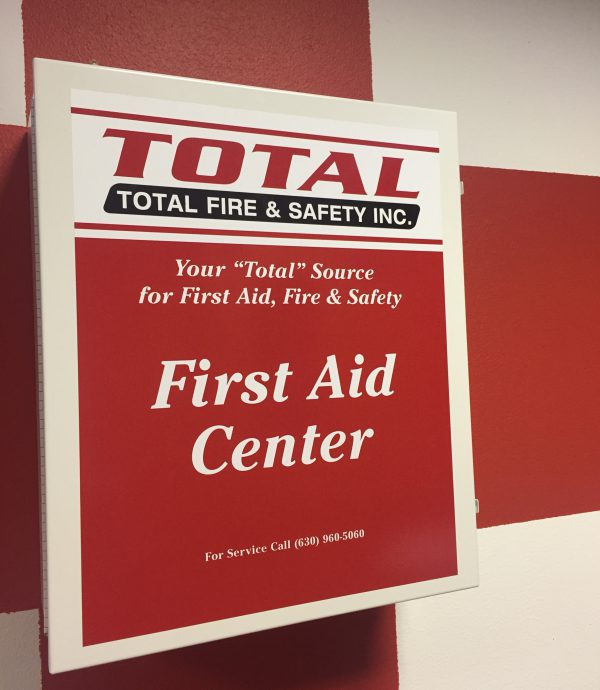
Does your organization have a first aid kit hanging on the wall? It sits there silently like a dutiful soldier, ready and waiting for any emergency. But with winter on its way, you may be surprised at how often that first aid kit can be called into service during the coldest months of the year.
Winter weather can easily compromise employee safety, whether the workplace is outdoors or in an office. It is important to keep first aid kits well stocked with winter safety essentials. Before you start planning your holiday office party, let’s look at your first aid kit and what we can do to “winterize” it.
OSHA has established a list of required first aid supplies for the workplace. Depending on the business and specifics of the environment, there are different first aid requirements. Employers are responsible for keeping the first aid kit stocked and up to date with the necessary supplies needed. They include:
- Band-aids, Elastic Bandages/Adhesive Tape, Sterile Gauze Pads/Rolls and Large Pressure Bandages in different shapes and sizes of bandages for possible falls, cuts, and scrapes. The opening of cracked, chapped winter skin can precipitate the need for a band-aid or a fall on the ice can merit more serious first aid treatment.
- Non-Latex Gloves, Antiseptic wipes, Peroxide and Alcohol and Triple Antibiotic Ointment will help keep those helping tend a wound safe, and also help the wound heal more quickly. Protect skin from contamination.
- Eye Pads and Eye Wash can help tend weather-related discomforts on the way into work.
- Tongue Depressors can be used to check throat irritations during winter flu season or be used as splints for possible weather-related injuries.
- CPR Shields can protect users from bodily fluids when CPR is essential. In winter, shoveling and overexertion in the cold can lead to cardiac arrest and the need for onsite CPR. Total Fire & Safety can help with employee training in this area.
- Triangular Bandages can be onsite in the event of the need for a sling or tourniquet. Falls on ice or minor accidents may require such dressings.
- Cold Packs: Instant cold packs help with sprains, fractures, burns, etc.… common injuries associated with falls, accidents, or overheating.
- Thermometer: Determines body temperatures. The flu and other winter maladies can be contagious! Detecting an above normal temperature in an employee can prevent an outbreak that can take down a workplace.
- Aspirin, Tylenol, or Motrin can help alleviate the symptoms of a cold.
- Penlight can be used to look in ears and throats for maladies, or even pupils for possible concussion victims.
- Antihistamine Tablets and Hydrocortisone to quell the allergies and dermatitis from the dry air, increased dust, and lack of fresh air during the winter months.
- Blankets to use in emergencies, such as frostbite, hypothermia, etc.
For any company, the first aid kit can be your first offense against the common winter injuries that employees can suffer en route or while at work:
Sprains and Broken Bones
Ice covered roadways, sidewalks, parking lots, and driveways put you at risk for a nasty fall which can result in a sprain or broken bone. If the injury is minor and does not require an immediate doctor’s care, delve into your first aid kit and treat the injury with RICE:
1. Rest the injured limb with crutches, a sling, or splint, or anything you can to keep from putting stress on it.
2. Ice the injured limb. Apply a cold pack to the area to prevent swelling.
3. Compress the injury by wrapping a bandage around it or use a sleeve.
4. Elevate the injured limb above the heart to reduce swelling.
In addition, offer the victim Tylenol, Aspirin, or Motrin for pain and swelling.
Frostbite
Frostbite occurs when skin cells and tissues freeze, damaging the skin walls. Most often it happens to fingers, toes, noses, cheeks, chin, ears, and the areas with most exposed skin. If frost bite should happen, remove the victim from the cold. Warm their hands by tucking them under the armpits. Cover the nose, ears, and face and remove any wet clothing. Once in warm shelter, place frostbitten areas under warm, not hot, water. Avoid direct heat. Treat pain with Tylenol, Aspirin, or Motrin from your first aid kit. If blisters or numbness continues, seek medical attention.
Hypothermia
Hypothermia happens when the body’s internal temperature drops below 95 degrees. Call 911 immediately. A person’s breath can become shallow or they can stop breathing all together. If this happens, CPR must be administered using a CPR shield from your first aid kit. If CPR is not necessary, get the person away from the cold and wrap them in a blanket, also in your first aid kit. Apply a warm compress to the chest, neck, groin, and head.
Winter weather can be dangerous and serious injuries can occur, beyond what a first aid kit is capable to handle. Assess the situation and call 911, if needed, first.
Total Fire and Safety can help you keep your first aid kits stocked appropriately and provide on-site first aid training for employees. Be prepared for winter! Give us a call today! (630)960-5060.
 Facebook
Facebook
 Instagram
Instagram
 LinkedIn
LinkedIn
